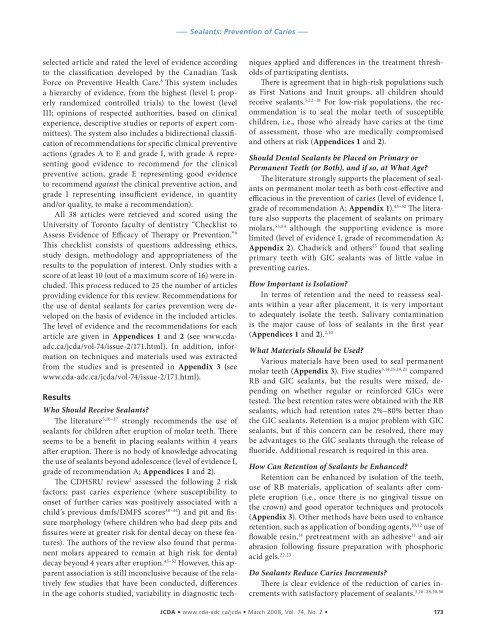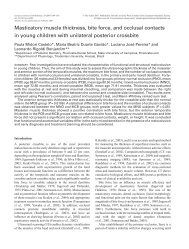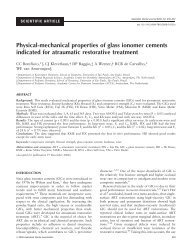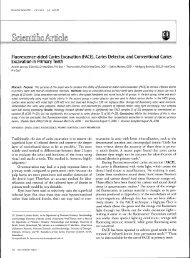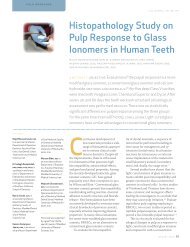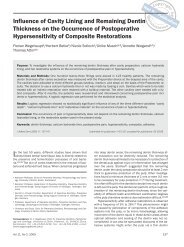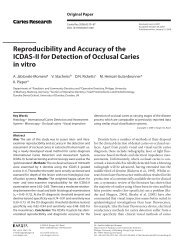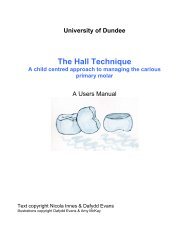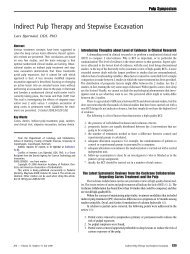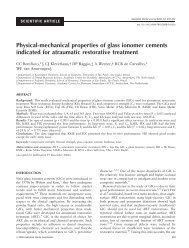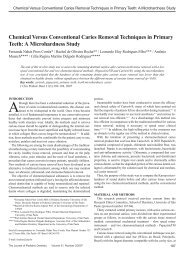Pit and Fissure Sealants in the Prevention of Dental Caries in ...
Pit and Fissure Sealants in the Prevention of Dental Caries in ...
Pit and Fissure Sealants in the Prevention of Dental Caries in ...
Create successful ePaper yourself
Turn your PDF publications into a flip-book with our unique Google optimized e-Paper software.
––– <strong>Sealants</strong>: <strong>Prevention</strong> <strong>of</strong> <strong>Caries</strong> –––<br />
selected article <strong>and</strong> rated <strong>the</strong> level <strong>of</strong> evidence accord<strong>in</strong>g<br />
to <strong>the</strong> classification developed by <strong>the</strong> Canadian Task<br />
Force on Preventive Health Care. 8 This system <strong>in</strong>cludes<br />
a hierarchy <strong>of</strong> evidence, from <strong>the</strong> highest (level I; properly<br />
r<strong>and</strong>omized controlled trials) to <strong>the</strong> lowest (level<br />
III; op<strong>in</strong>ions <strong>of</strong> respected authorities, based on cl<strong>in</strong>ical<br />
experience, descriptive studies or reports <strong>of</strong> expert committees).<br />
The system also <strong>in</strong>cludes a bidirectional classification<br />
<strong>of</strong> recommendations for specific cl<strong>in</strong>ical preventive<br />
actions (grades A to E <strong>and</strong> grade I, with grade A represent<strong>in</strong>g<br />
good evidence to recommend for <strong>the</strong> cl<strong>in</strong>ical<br />
preventive action, grade E represent<strong>in</strong>g good evidence<br />
to recommend aga<strong>in</strong>st <strong>the</strong> cl<strong>in</strong>ical preventive action, <strong>and</strong><br />
grade I represent<strong>in</strong>g <strong>in</strong>sufficient evidence, <strong>in</strong> quantity<br />
<strong>and</strong>/or quality, to make a recommendation).<br />
All 38 articles were retrieved <strong>and</strong> scored us<strong>in</strong>g <strong>the</strong><br />
University <strong>of</strong> Toronto faculty <strong>of</strong> dentistry “Checklist to<br />
Assess Evidence <strong>of</strong> Efficacy <strong>of</strong> Therapy or <strong>Prevention</strong>.” 9<br />
This checklist consists <strong>of</strong> questions address<strong>in</strong>g ethics,<br />
study design, methodology <strong>and</strong> appropriateness <strong>of</strong> <strong>the</strong><br />
results to <strong>the</strong> population <strong>of</strong> <strong>in</strong>terest. Only studies with a<br />
score <strong>of</strong> at least 10 (out <strong>of</strong> a maximum score <strong>of</strong> 16) were <strong>in</strong>cluded.<br />
This process reduced to 25 <strong>the</strong> number <strong>of</strong> articles<br />
provid<strong>in</strong>g evidence for this review. Recommendations for<br />
<strong>the</strong> use <strong>of</strong> dental sealants for caries prevention were developed<br />
on <strong>the</strong> basis <strong>of</strong> evidence <strong>in</strong> <strong>the</strong> <strong>in</strong>cluded articles.<br />
The level <strong>of</strong> evidence <strong>and</strong> <strong>the</strong> recommendations for each<br />
article are given <strong>in</strong> Appendices 1 <strong>and</strong> 2 (see www.cdaadc.ca/jcda/vol-74/issue-2/171.html).<br />
In addition, <strong>in</strong>formation<br />
on techniques <strong>and</strong> materials used was extracted<br />
from <strong>the</strong> studies <strong>and</strong> is presented <strong>in</strong> Appendix 3 (see<br />
www.cda-adc.ca/jcda/vol-74/issue-2/171.html).<br />
Results<br />
Who Should Receive <strong>Sealants</strong><br />
The literature 5,10–37 strongly recommends <strong>the</strong> use <strong>of</strong><br />
sealants for children after eruption <strong>of</strong> molar teeth. There<br />
seems to be a benefit <strong>in</strong> plac<strong>in</strong>g sealants with<strong>in</strong> 4 years<br />
after eruption. There is no body <strong>of</strong> knowledge advocat<strong>in</strong>g<br />
<strong>the</strong> use <strong>of</strong> sealants beyond adolescence (level <strong>of</strong> evidence I,<br />
grade <strong>of</strong> recommendation A; Appendices 1 <strong>and</strong> 2).<br />
The CDHSRU review 2 assessed <strong>the</strong> follow<strong>in</strong>g 2 risk<br />
factors: past caries experience (where susceptibility to<br />
onset <strong>of</strong> fur<strong>the</strong>r caries was positively associated with a<br />
child’s previous dmfs/DMFS scores 38–44 ) <strong>and</strong> pit <strong>and</strong> fissure<br />
morphology (where children who had deep pits <strong>and</strong><br />
fissures were at greater risk for dental decay on <strong>the</strong>se features).<br />
The authors <strong>of</strong> <strong>the</strong> review also found that permanent<br />
molars appeared to rema<strong>in</strong> at high risk for dental<br />
decay beyond 4 years after eruption. 45–52 However, this apparent<br />
association is still <strong>in</strong>conclusive because <strong>of</strong> <strong>the</strong> relatively<br />
few studies that have been conducted, differences<br />
<strong>in</strong> <strong>the</strong> age cohorts studied, variability <strong>in</strong> diagnostic techniques<br />
applied <strong>and</strong> differences <strong>in</strong> <strong>the</strong> treatment thresholds<br />
<strong>of</strong> participat<strong>in</strong>g dentists.<br />
There is agreement that <strong>in</strong> high-risk populations such<br />
as First Nations <strong>and</strong> Inuit groups, all children should<br />
receive sealants. 5,12–18 For low-risk populations, <strong>the</strong> recommendation<br />
is to seal <strong>the</strong> molar teeth <strong>of</strong> susceptible<br />
children, i.e., those who already have caries at <strong>the</strong> time<br />
<strong>of</strong> assessment, those who are medically compromised<br />
<strong>and</strong> o<strong>the</strong>rs at risk (Appendices 1 <strong>and</strong> 2).<br />
Should <strong>Dental</strong> <strong>Sealants</strong> be Placed on Primary or<br />
Permanent Teeth (or Both), <strong>and</strong> if so, at What Age<br />
The literature strongly supports <strong>the</strong> placement <strong>of</strong> sealants<br />
on permanent molar teeth as both cost-effective <strong>and</strong><br />
efficacious <strong>in</strong> <strong>the</strong> prevention <strong>of</strong> caries (level <strong>of</strong> evidence I,<br />
grade <strong>of</strong> recommendation A; Appendix 1). 45–52 The literature<br />
also supports <strong>the</strong> placement <strong>of</strong> sealants on primary<br />
molars, 53,54 although <strong>the</strong> support<strong>in</strong>g evidence is more<br />
limited (level <strong>of</strong> evidence I, grade <strong>of</strong> recommendation A;<br />
Appendix 2). Chadwick <strong>and</strong> o<strong>the</strong>rs 55 found that seal<strong>in</strong>g<br />
primary teeth with GIC sealants was <strong>of</strong> little value <strong>in</strong><br />
prevent<strong>in</strong>g caries.<br />
How Important is Isolation<br />
In terms <strong>of</strong> retention <strong>and</strong> <strong>the</strong> need to reassess sealants<br />
with<strong>in</strong> a year after placement, it is very important<br />
to adequately isolate <strong>the</strong> teeth. Salivary contam<strong>in</strong>ation<br />
is <strong>the</strong> major cause <strong>of</strong> loss <strong>of</strong> sealants <strong>in</strong> <strong>the</strong> first year<br />
(Appendices 1 <strong>and</strong> 2). 2,10<br />
What Materials Should be Used<br />
Various materials have been used to seal permanent<br />
molar teeth (Appendix 3). Five studies 5,14,15,19,21 compared<br />
RB <strong>and</strong> GIC sealants, but <strong>the</strong> results were mixed, depend<strong>in</strong>g<br />
on whe<strong>the</strong>r regular or re<strong>in</strong>forced GICs were<br />
tested. The best retention rates were obta<strong>in</strong>ed with <strong>the</strong> RB<br />
sealants, which had retention rates 2%–80% better than<br />
<strong>the</strong> GIC sealants. Retention is a major problem with GIC<br />
sealants, but if this concern can be resolved, <strong>the</strong>re may<br />
be advantages to <strong>the</strong> GIC sealants through <strong>the</strong> release <strong>of</strong><br />
fluoride. Additional research is required <strong>in</strong> this area.<br />
How Can Retention <strong>of</strong> <strong>Sealants</strong> be Enhanced<br />
Retention can be enhanced by isolation <strong>of</strong> <strong>the</strong> teeth,<br />
use <strong>of</strong> RB materials, application <strong>of</strong> sealants after complete<br />
eruption (i.e., once <strong>the</strong>re is no g<strong>in</strong>gival tissue on<br />
<strong>the</strong> crown) <strong>and</strong> good operator techniques <strong>and</strong> protocols<br />
(Appendix 3). O<strong>the</strong>r methods have been used to enhance<br />
retention, such as application <strong>of</strong> bond<strong>in</strong>g agents, 10,12 use <strong>of</strong><br />
flowable res<strong>in</strong>, 14 pretreatment with an adhesive 11 <strong>and</strong> air<br />
abrasion follow<strong>in</strong>g fissure preparation with phosphoric<br />
acid gels. 22,23<br />
Do <strong>Sealants</strong> Reduce <strong>Caries</strong> Increments<br />
There is clear evidence <strong>of</strong> <strong>the</strong> reduction <strong>of</strong> caries <strong>in</strong>crements<br />
with satisfactory placement <strong>of</strong> sealants. 5,10–28,30,56<br />
JCDA • www.cda-adc.ca/jcda • March 2008, Vol. 74, No. 2 • 173


